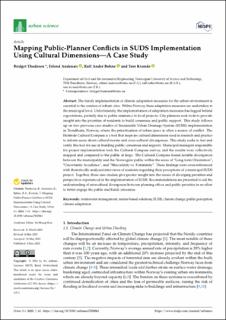| dc.description.abstract | The timely implementation of climate adaptation measures for the urban environment is essential to the creation of robust cities. Within Norway, these adaptation measures are undertaken at the municipal level. Unfortunately, the implementation of adaptation measures has lagged behind expectations, partially due to public resistance to local projects. City planners seek tools to provide insight into the priorities of residents to build consensus and public support. This study follows up on two previous case studies of Sustainable Urban Drainage System (SUDS) implementation in Trondheim, Norway, where the prioritization of urban space is often a source of conflict. The Hofstede Cultural Compass is a tool that maps six cultural dimensions used in research and practice to inform users about cultural norms and cross-cultural divergences. This study seeks to test and verify this tool for use in building public consensus and support. Municipal managers responsible for project implementation took the Cultural Compass survey, and the results were collectively mapped and compared to the public at large. The Cultural Compass found notable divergences between the municipality and the Norwegian public within the areas of “Long-term Orientation”, “Uncertainty Avoidance”, and “Masculinity vs. Femininity”. These findings were cross-referenced with thematically analyzed interviews of residents regarding their perceptions of a municipal SUDS project. Together, these case studies give greater insight into the issues of diverging priorities and perspectives experienced in the implementation of SUDS. Recommendations are presented to aid the understanding of intercultural divergences between planning offices and public priorities in an effort to better engage the public and build consensus. | en_US |

